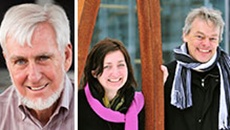John O'Keefe shares Medicine Nobel with May-Britt and Edvard Moser
06 Oct 2014
Anglo-American John O'Keefe and Norwegian couple May-Britt and Edvard Moser have been awarded the Nobel Prize in Physiology (Medicine) 2014, for discovering the brain's internal positioning system, that help researchers find clues to how strokes and Alzheimer's affect the brain.
 The Nobel Prize in Physiology or Medicine 2014 was awarded with one half of the 8 million Swedish crowns ($1.27 million) prize money will go to John O'Keefe and the other half jointly to May-Britt Moser and Edvard I Moser ''for their discoveries of cells that constitute a positioning system in the brain,'' the Nobel Prize Committee said in a release.
The Nobel Prize in Physiology or Medicine 2014 was awarded with one half of the 8 million Swedish crowns ($1.27 million) prize money will go to John O'Keefe and the other half jointly to May-Britt Moser and Edvard I Moser ''for their discoveries of cells that constitute a positioning system in the brain,'' the Nobel Prize Committee said in a release.
| The Nobel Assembly, which awarded the prize at Sweden's Karolinska Institute, said the discovery solved a problem that has occupied philosophers and scientists for centuries: "How does the brain create a map of the space surrounding us and how can we navigate our way through a complex environment?" |
''This year's Nobel Laureates have discovered a positioning system, an ''inner GPS'' in the brain that makes it possible to orient ourselves in space, demonstrating a cellular basis for higher cognitive function,'' it added.
Professor O'Keefe is now director at the centre in neural circuits and behaviour at University College London.
In 1971, John O´Keefe discovered the first component of this positioning system. He found that a type of nerve cell in an area of the brain called the hippocampus that was always activated when a rat was at a certain place in a room. Other nerve cells were activated when the rat was at other places. O´Keefe concluded that these ''place cells'' formed a map of the room.
More than three decades later, in 2005, May-Britt and Edvard Moser discovered another key component of the brain's positioning system. They identified another type of nerve cell, which they called ''grid cells'' that generate a coordinate system and allow for precise positioning and pathfinding. Their subsequent research showed how place and grid cells make it possible to determine position and to navigate.
In 1996, the Mosers, who are married and now based in scientific institutes in the Norwegian town of Trondheim, worked with Professor O'Keefe to learn how to record the activity of cells in the hippocampus.
Nearly a decade later, the Moser team discovered cells, in the entorhinal cortex region in brains of rats, which function as a navigation system.
These so-called "grid cells", they discovered, are constantly working to create a map of the outside world and are responsible for animals' knowing where they are, where they have been, and where they are going.
The finding, a fundamental piece of research, explains how the brain works, but does not have immediate implications for new medicines, since it does not set out a mechanism of action.
But knowledge about the brain's positioning system can help understand what causes loss of spatial awareness in stroke patients or those with devastating brain diseases like dementia, of which Alzheimer's is the most common form and affects 44 million people worldwide.
Ole Kiehn, a Nobel committee member and professor in the Department of Neuroscience at Karolinska Institute, said the three scientists had found "an inner GPS that makes it possible to know where we are and find our way".
Recent investigations with brain imaging techniques, as well as studies of patients undergoing neurosurgery, have provided evidence that in patients with Alzheimer´s disease, the hippocampus and entorhinal cortex are frequently affected at an early stage, and these individuals often lose their way and cannot recognise the environment.
Knowledge about the brain´s positioning system may, therefore, help us understand the mechanism underpinning the devastating spatial memory loss that affects people with this disease.
The discovery of the brain's positioning system represents a paradigm shift in our understanding of how ensembles of specialized cells work together to execute higher cognitive functions. It has opened new avenues for understanding other cognitive processes, such as memory, thinking and planning, the Nobel Committee added.






























